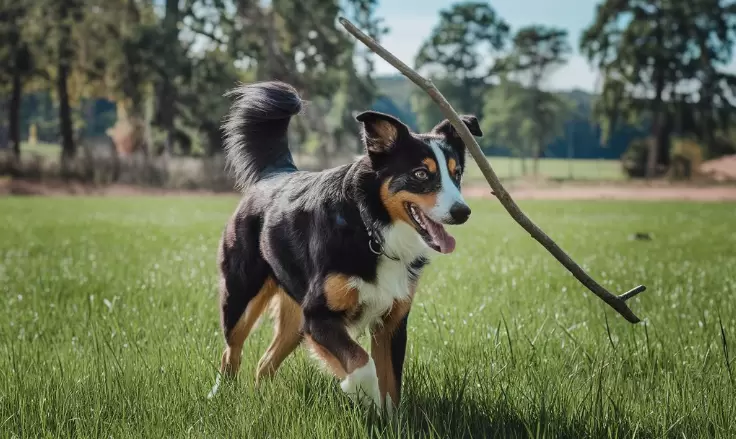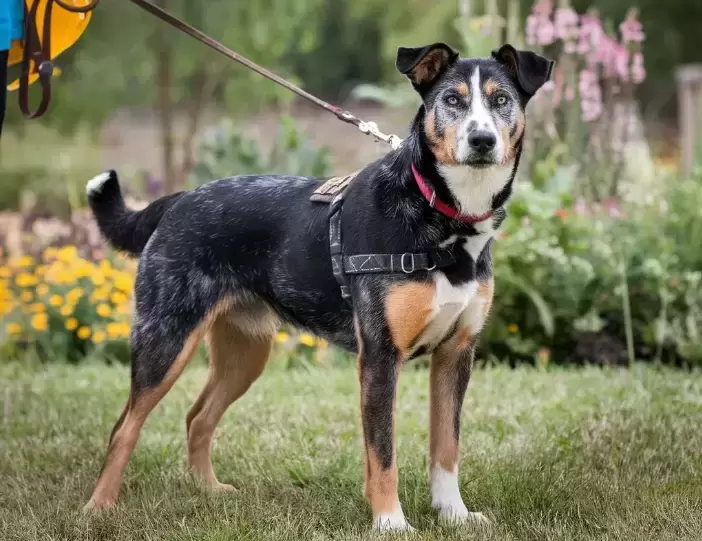Are you considering bringing a Blue Heeler Australian Shepherd mix into your family? This comprehensive guide provides all the necessary information on this energetic and intelligent crossbreed, often referred to as Texas Heeler. We’ve detailed all they are like and how best these versatile pets need to be catered for.
Introduction: Meet the Blue Heeler Australian Shepherd Mix
The Blue Heeler Australian Shepherd mix is an impressive combination of the two most renowned herding dogs across America that has enchanted all dog lovers. This specific hybrid takes qualities from both Australian Cattle Dogs (Blue Heeler) known for its intelligence and Australian Shepherds’ nimbleness plus adaptability. The result is an energetic, devoted companion fitting for any environment-from ranches to your favorite armchair.
Key Characteristics:
- Medium-sized dog
- High energy levels
- Intelligent and trainable
- Strong herding instincts
- Loyal and protective
In exploring the depths of Blue Heeler Australian Shepherd mix, you will find out why this breed could be ideal for your dynamic way of life.
Origin and History: A Tale of Two Herders

To know exactly the Blue Heeler Australian Shepherd mix, you have to think about its ancestry. Both these dogs are very old and were bred by people taking care of their cattle as well as sheep.
The Blue Heeler (Australian Cattle Dog)
The origin of the Australian Cattle Dog, commonly known as the Blue Heeler, can be traced back to Australia in the 19th century. The ranchers required a robust, clever dog that would withstand the environmental elements of the outback and control cattle over wide disparities. The Blue Heeler was produced through selective breeding of Dingoes, Collies and various herding breeds.
Blue Heeler Traits:
- Exceptional intelligence
- High stamina
- Strong work ethic
- Protective nature
The Australian Shepherd
No matter what this breed is called, it was developed in the western United States. This kind of dog was highly valued by ranchers and cowboys who appreciated its herding abilities.
Australian Shepherd Traits:
- Agility and athleticism
- Keen intelligence
- Eager to please
- Versatile working abilities
The Birth of the Blue Heeler Australian Shepherd Mix
As ranchers attempted to merge the optimal characteristics of both breeds, there arose the Blue Heeler Australian Shepherd mix also known as Texas Heeler. Because of this, one of its nicknames suggests that it was probably born in Texas.
“Blue Heeler Australian Shepherd mix is the highest representation of two worlds: it has both Blue Heeler’s tenacity and Australian’s versatility.” John Smith; Dog Trainer Pro
Physical Characteristics: A Unique Blend

The Blue Heeler Australian Shepherd mix is a dog of medium size, solid build that reveals its working ancestry. Let’s break down their physical traits:
Size and Weight
| Aspect | Male | Female |
| Height | 18-23 inches | 17-21 inches |
| Weight | 35-60 lbs. | 30-50 lbs. |
Coat Types and Colors
A tremendous variety of colors and patterns occur in the coats of Blue Heeler Australian Shepherd mixes, which are a combination of their parents. Common colors include:
- Blue merle
- Red merle
- Black
- Red
- Ticked coat pattern
Usually, the length of their coat is medium and thick which keeps them safe from the external conditions. The Aussie Blue Heeler mix may possess either the distinctive merle coloring typical of Australian Shepherd dogs or Blue Heeler dogs’ ticked pattern.
Distinctive Features
- Ocular organs: Almond shaped eyeballs whose hues may range from blue to brown or even possess different colored retinas (polychromatic eyes)
- Hearing appendages: Erect ears or semi-erect ones that are very observant and expressive
- Tail: Natural bobtail or full tail, depending on genetics
Temperament and Personality: A Dog with Drive

Unlike a typical dog that loves to snuggle with people, the Blue Heeler Australian Shepherd mix has always been known for its strength and workaholic nature. Most of the time it’s very energetic since it was bred mainly to herd cattle. Here’s what you should know:
- Intelligence: The Blue Heeler Australian Shepherd mix is one of the most intelligent hybrids because of its parents’ intelligence.
- Energy Levels: A dog that requires a lot of physical activity and mental stimulation is what you should expect. A bored Heeler Australian Shepherd mix can become destructive.
- Herding Instincts: In case your kids or different pets start being herded by your Blue Heeler Australian Shepherd mix, don’t be astonished. It’s just in their blood!
- Devotion: Such dogs develop deep associations with their homes and can serve as guards for them.
- Sociability: Early socialization is crucial. They are friendly yet standoffish with strangers.
- “The Blue Heeler Australian Shepherd mix is a versatile, dependable, and always ready for action kind of dog like a Swiss army knife.” Sarah Johnson, Veterinarian
Training and Mental Stimulation: Keeping Their Minds Sharp
Achieving the right level of training for a Blue Heeler Australian Shepherd mix can be both satisfying and complex, as these dogs can be eager learners but at times also quite obstinate. Here is how to optimize their intelligence:
Early Socialization
Expose your Heeler Australian Shepherd mix to various people, animals, and situations from a young age. This helps prevent fear and aggression later in life.
Obedience Training Techniques
- Use positive reinforcement
- Keep training sessions short and fun
- Be consistent with commands
- Incorporate play into training
Task-Oriented Activities
Give your Blue Heeler Australian Shepherd mix a job to do. This could be:
- Agility training
- Herding trials
- Obedience competitions
- Therapy dog work
Addressing Behavioral Challenges
Common issues:
- Nipping at heels (herding behavior)
- Excessive barking
- Destructive behavior when bored
Solutions:
- Redirect nipping to appropriate toys
- Teach a “quiet” command
- Provide plenty of mental and physical exercise
Exercise Requirements: Keeping Up with Your Energetic Companion
The Blue Heeler Australian Shepherd mix is one of those breeds that have higher energy levels and demand daily exercises at a considerable amount. If they are not exercised properly, they will misbehave.
Daily Exercise Needs
At least one to two hours of intense workouts each day is what you should be striving for. This can include:
- Long walks or jogs
- Fetch sessions
- Swimming
- Hiking
Suitable Activities
- Agility: Set up an obstacle course in your backyard.
- Frisbee: Great for burning energy and bonding.
- Herding Trials: Let them showcase their natural instincts.
- Bike joking: For the adventurous owner.
Mental Stimulation Games
Don’t forget to exercise their minds too! Try:
- Puzzle toys
- Hide and seek
- Nose work games
- Obedience training sessions
“A tired Blue Heeler Australian Shepherd mix is a happy Blue Heeler Australian Shepherd mix. These dogs thrive on activity and purpose.” – Mike Thompson, Professional Dog Walker
Health Concerns: Keeping Your Mix in Top Shape
Some health problems might still happen to the Blue Heeler Australian Shepherd mix although cross breeds are supposed to benefit from hybrid vigor. Look out for the following:
Common Genetic Health Issues
- Hip Dysplasia: Common in medium to large breeds
- Progressive Retinal Atrophy (PRA): Can lead to blindness
- Deafness: Particularly in dogs with the merle coat gene
- Epilepsy: Can be managed with medication.
Preventative Care Measures
- Regular exercise to maintain a healthy weight
- High-quality diet appropriate for their activity level
- Routine dental maintenance serves to avert gum illness.
- Fleas, ticks, and heartworms need to be prevented regularly
Vet Visits for Dogs
At least annually schedule appointments for check-ups or regularly for older dogs. By this way, possible problems may be detected at an early stage by your vet.
Nutrition and Diet Recommendations
You should feed your Blue Heeler Australian Shepherd mix with good quality dog food which is suitable for their age, size and activity level. Consider:
- Protein-rich diets for active dogs
- Portion control to prevent obesity
- Avoiding table scraps and excessive treats
Grooming Needs: Keeping Your Mix Looking Sharp
A Blue Heeler Australian Shepherd hybrid has a coat of medium-length that requires routine grooming. In this regard, here are some tips on how to maintain their appearance:
Coat Care and Shedding Management
- Brush 2-3 times a week, more during shedding seasons
- Use a slicker brush and undercoat rake for thorough grooming
- Consider professional grooming every 6-8 weeks
Bathing Frequency
If necessary, wash your Blue Heeler Australian Shepherd mix with water every six to eight weeks. Excessive bathing may lead to loss of natural oils from their coat.
Nail Trimming and Dental Hygiene
- Trim nails every 2-3 weeks
- Brush teeth 2-3 times a week to prevent dental issues
Ear Cleaning and Eye Care
- Check and clean ears weekly to prevent infections
- Wipe around eyes daily to prevent tear staining
Living Environment: Creating the Perfect Space
Although the blue heeler Australian shepherd mix is versatile, it does best in certain climates. Here are some tips for creating a great living space:
Space Requirements
Though ambling around inside an apartment will suffice provided there is enough exercise, this hyperactive breed is preferably housed in homes with backyards.
Indoor vs. Outdoor Living
An indoor dog breed with indoor spaces perceived as its playground can be described as a Blue Heeler Australian Shepherd mix breed.
Climate Considerations
There is a possibility that extra care will be required during extreme temperature conditions; therefore, although these dogs might adjust in any kind of weather they face.
Fencing and Safety Precautions
Secure fencing is a must to prevent escape. Remember, these dogs can jump and climb!
Family Compatibility: Is This the Right Dog for You?

For the appropriate family, the Blue Heeler Australian Shepherd mix has the potential to be an excellent family friend. Consider these factors:
Interaction with Children
- Great with older children who understand how to interact with dogs
- May try to herd young children
- Always supervise interactions between dogs and kids
Suitability for First-Time Dog Owners
For novice managers, this species may present some difficulties that revolve around their level of enthusiasm and wisdom. The ideal choice would therefore be someone with experience in handling dogs.
Multi-Pet Households
If you socialize properly, the Blue Heeler Australian Shepherd mix can befriend other pets. However, the herding instincts may create problems especially when there are small animals around.
Adapting to Different Lifestyles
Active families that can offer abundant exercise and mental engagement are the most appropriate owners for these dogs.
Adoption and Purchasing: Finding Your Perfect Match
Is it that you are prepared to have a Blue Heeler Australian Shepherd mix added to your home? Then here’s how:
Finding Reputable Breeders
- Research breeders thoroughly
- Ask for health clearances for both parent breeds
- Visit the breeder’s facility if possible
- Ask about the temperament of the parent dogs
Rescue Organizations
Rescue organizations that focus on mixed breeds for herding dogs are worth thinking about for adoption. Due to the requirements for lots of energy, many of the Blue Heeler Australian Shepherd mixes are left in the shelter.
Questions to Ask Before Bringing One Home
- What is the dog’s energy level?
- How much exercise do they require daily?
- Are they good with children/other pets?
- What health issues have they experienced?
- What training have they received?
Initial Costs and Ongoing Expenses
- Prepared should you be for the monetary responsibility that comes with having a Blue Heeler Australian Shepherd mix:
- Initial cost: $500-$2000 (adoption fees or purchase price)
- Annual expenses: $1000-$2000 (food, vet care, grooming, toys)
Real-Life Stories: Living with a Blue Heeler Australian Shepherd Mix
This is how some owners have described their experiences with this unusual crossbreed:
“Our Blue Heeler Australian Shepherd mix, Max, was not only a remarkable addition to our family but also an active one as well. It is his energy that makes it possible for us to remain active while his intelligence never ceases to awe us.” – The Johnson Family
“To us, adopting Bella, our Heeler Australian Shepherd mix was arguably the best decision we ever made. She exhibits qualities of being a faithful friend through thick and thin while at the same time being a good keeper of the house; though her instincts towards herding can sometimes appear rough around the edges considering that in time through consistency in training she has been able to get rid of her habit of biting.” – Tom and Lisa Martinez
Frequently Asked Questions (FAQs):
Q1: Can Blue Heeler Australian Shepherd mixes be good apartment dogs?
A: They may be able to live in apartments, but not nicely. There’s a lot of energy in these breeds and they need a lot of room to run around and play. Apartment dwellers need to take them out for walks at least twice a day, visit dog parks with them and also play inside the house. Otherwise, without enough physical exercise and mental stimulation, they could be difficult pets indeed.
Q2: How does the Blue Heeler Australian Shepherd mix cope with its solitude?
A: Being that they are bright and energetic canines, these breeds don’t do well at all when left alone for long spells. They might experience separation anxiety causing them to engage in anything from destroying furniture to barking unnecessarily. Preference should be given to slowly getting them used to solitude in addition to providing enough stimulating toys as well as seeking a dog boarding facility or pet guardian if one will be out of town for a long time.
Q3: Blue Heeler Australian Shepherd mixes: are they aggressive?
A: Blue Heeler Australian Shepherd mixes tend to be quite sociable in nature, however if they do not get proper socialization their aggression may surface to some extent. High herding behavior may include chasing or nipping that looks aggressive. Therefore it is important for these dogs to be properly trained early enough, maintained with regular reinforcement of good behavior and socialized within packs so that they can be polite and friendly towards people.
Q4: Can Blue Heeler Australian Shepherd mixes live peacefully with cats?
A: It all depends on the individual dog and how early he was socialized. Some may view cats as something to herd, which can lead to chasing. Others may coexist peacefully, especially if raised together from a young age. You need to introduce them slowly and watch over everything they do together. If you are patient and give your Blue Heeler Australian Shepherd mixes the right kind of training, it is possible for them to become friends with cats.
Q5: Barking level of blue heeler Australian shepherd mix?
A: These dogs tend to be very noisy, thanks to their herding background and watchdog tendencies. They may bark to alert you of perceived threats or out of boredom. Training them with a “quiet” command and providing adequate mental and physical stimulation can help manage excessive barking. It is important to understand that some barking is normal and should not be completely discouraged.
Conclusion: Is the Blue Heeler Australian Shepherd Mix Right for You?
This rare breed of Blue Heeler Australian Shepherd mix has caught many people’s attention since it has the advantage of two distinct but unique worlds; thus they are a combination of intelligence, discipline and hard work as well as agility, speed and versatility. They may not appeal to all dog lovers; however, these dogs make very good friends for those who can appreciate their worth.
A Blue Heeler Australian Shepherd mix might be just right if you have an active lifestyle or happen to be one of those families who are always on the move. Their undivided loyalty makes them preferable choice of dogs but they require more energy and time for training among other requirements unlike any other pet similar to it on planet earth. Remember though that taking care of any dog is not easy at all, so make sure to consider whether or not you can handle that beforehand otherwise just don’t even think about getting one.
Also, given the true tenderness of the animal, sticking strong to care, there are chances of a 12-16 years friendship with your blue heeler Australian shepherd mix just like human friends. Your life will then be filled with life and laughter full of strength.

Rupert Boneham has been a prominent and celebrated blog writer since 2013, earning a reputation as one of the most renowned voices in the industry. With his exceptional ability to deliver engaging and insightful content, Rupert has captured the attention of a diverse audience, consistently standing out for his innovative and impactful writing. His deep knowledge and unique perspective have solidified his status as a leading figure in the blogging world, where his work continues to inspire and resonate with readers around the globe.